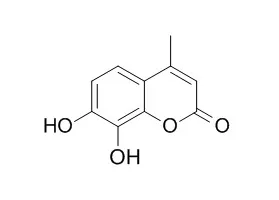5. Cloricromene, a synthetic coumarin derivative, also possesses antithrombotic antiplatelet actions, inhibits PMN neutrophil function and causes vasodilatation. Some of these properties of cloricromene have been ascribed to inhibition of arachidonate release from membrane phospholipids.
METHODS AND RESULTS:
6. Simple coumarins possessing ortho-dihydroxy functions, such as fraxetin and 4-Methyldaphnetin, are potent inhibitors (low micromolar) of lipid peroxidation and scavengers of superoxide anion radicals and of aqueous alkylperoxyl radicals, but may be pro-oxidant (enhancing generation of hydroxyl radicals) in the presence of free iron ions.
These coumarins also inhibit the proinflammatory 5-lipoxygenase enzyme at micromolar concentrations. Another related coumarin, 5,7-dihydroxy-4-methylcoumarin, is of special interest as it inhibits lipid peroxidation, and scavenges alkylperoxyl and superoxide radicals. Unlike most other simple coumarins studied, 5,7-dihydroxy-4-methylcoumarin also scavenges hypochlorous acid, and is a potent inhibitor of cyclo-oxygenase, but is not pro-oxidant. 7. 5,7- and 6,7-dihydroxy-4-methylcoumarin both reduced the duration of ventricular fibrillation in postischaemic reperfused isolated perfused rat hearts (in which oxygen-derived free radicals are implicated), showing that these antioxidant coumarins possess beneficial properties in this pathophysiological model.
CONCLUSIONS:
8. In view of the established low toxicity, relative cheapness, presence in the diet and occurrence in various herbal remedies of coumarins, it appears prudent to evaluate their properties and applications further. |






 Cell. 2018 Jan 11;172(1-2):249-261.e12. doi: 10.1016/j.cell.2017.12.019.IF=36.216(2019)
Cell. 2018 Jan 11;172(1-2):249-261.e12. doi: 10.1016/j.cell.2017.12.019.IF=36.216(2019) Cell Metab. 2020 Mar 3;31(3):534-548.e5. doi: 10.1016/j.cmet.2020.01.002.IF=22.415(2019)
Cell Metab. 2020 Mar 3;31(3):534-548.e5. doi: 10.1016/j.cmet.2020.01.002.IF=22.415(2019) Mol Cell. 2017 Nov 16;68(4):673-685.e6. doi: 10.1016/j.molcel.2017.10.022.IF=14.548(2019)
Mol Cell. 2017 Nov 16;68(4):673-685.e6. doi: 10.1016/j.molcel.2017.10.022.IF=14.548(2019)